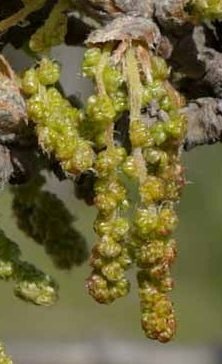Oregon white oak
(Quercus garryana)

Description
Quercus garryana is an oak tree species of the Pacific coast of North America, with a range stretching from southern California to southwestern British Columbia. It is commonly known as the Oregon white oak or Oregon oak in the United States and as the Garry oak in Canada. It grows from sea level to an altitude of 210 metres (690 feet) in the northern part of its range, and from 300 to 1,800 m (980 to 5,910 ft) in the south of the range in California. The eponymous Nicholas Garry was a deputy governor of the Hudson's Bay Company. It is typically of medium height, growing slowly to around 25 metres (82 feet) and occasionally as high as 30 m, or in shrub form to 3 to 5 m (10 to 16+1⁄2 ft) tall. The trunks grow to 90 centimetres (35 in) thick, exceptionally 1.5 m (5 ft). The bark is gray and fissured. It has the characteristic oval profile of other oaks when solitary, but is also known to grow in groves close enough together that crowns may form a canopy. The leaves are deciduous, 5–15 cm (2–6 in) long and 2–8 cm broad, with 3–7 deep lobes on each side, darker green on top and finely haired below. The flowers are catkins, the fruit a small acorn 2–3 cm (rarely 4 cm) long and 1.5–2 cm broad, with shallow, scaly cups. Its fall color is unspectacular, with many trees turning plain brown. Other individuals may have subtle mixtures of brown, green and yellow, or in less common cases a fairly bright 'peas and corn' effect. The Oregon white oak is commonly found in the Willamette Valley hosting the mistletoe Phoradendron flavescens. It is also commonly found hosting galls created by wasps in the family Cynipidae. 'Oak apples', green or yellow ball of up to 5 cm in size, are the most spectacular. They are attached to the undersides of leaves. One common species responsible for these galls is Cynips maculipennis. Other species create galls on stems and leaves. Shapes vary from spheres to mushroom-shaped to pencil-shaped. Individual specimens can grow to around 500 years in age, such as those on Sauvie Island near Portland, Oregon. In Oregon, the tree grows on the west side of the Cascade Range, primarily in the Willamette, Umpqua and Rogue River valleys, and along the Columbia River Gorge, as well as in canyons adjacent to the gorge.
Taxonomic tree:







